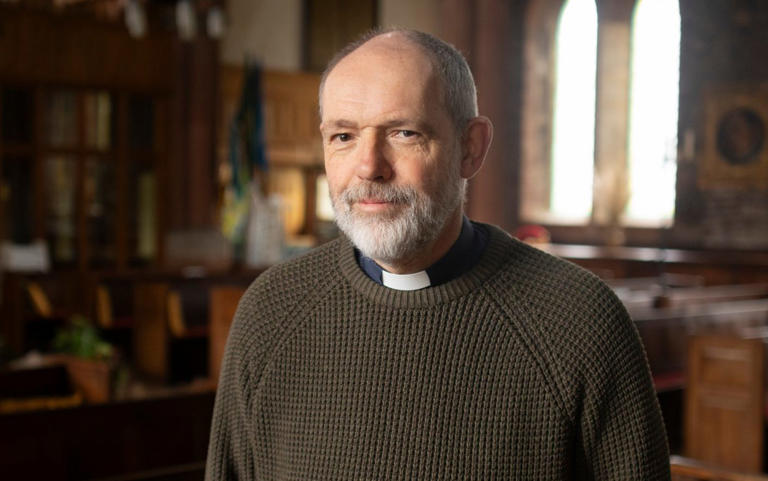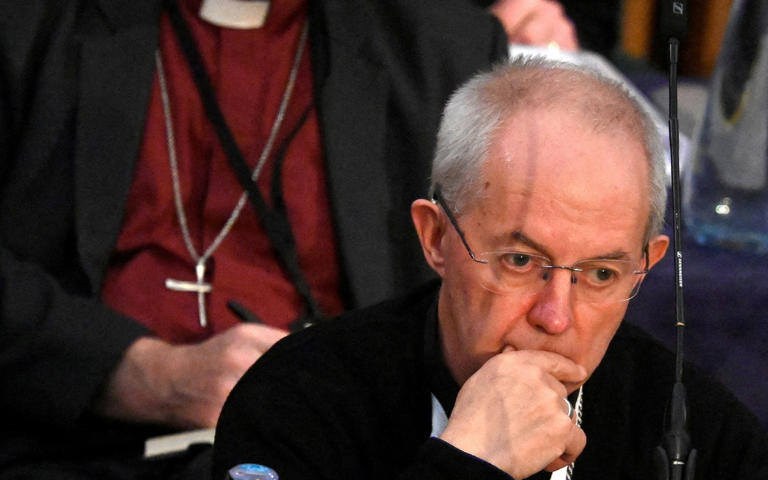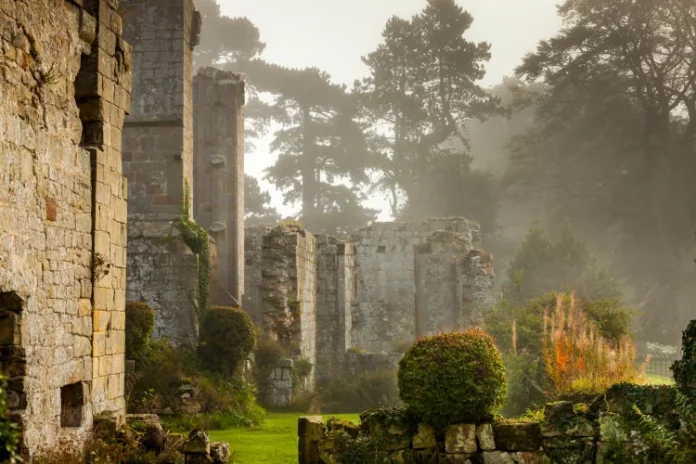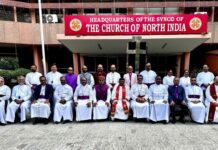On Sunday, the Reverend Greg Smith, rector of St George’s in the small south Shropshire market town of Pontesbury, will be leading services in three of the six far-flung churches that make up the benefice – or extended parish – that he heads.
Two other clergy will assist him with the rest, one of them St Luke’s, Snailbeach, now designated a “festival church”, meaning usage is so low it is only open on holy and high days.
“I’ve got a 6.30am, a nine o’clock and a 10.30am,” says Smith. “That is going to be a lot of running around in the car, rushing out of one church and into the next, never spending time with people, not able to prepare properly.”
It was not what he thought he was signing up for three years ago when he came to rural Shropshire after 22 years in a suburban parish in Coventry. “If you had said to me before I took up this appointment that I’d be responsible for six churches, I’d have said, ‘That’s not me’. It’s been quite an education.”
He is anticipating a substantial increase on Sunday on the 40-50 usually in the pews at St George’s, a 13th-century, stone-built church with space for 400, as well as a boost across the benefice where the weekly congregation in all six churches is around 120. Away from the big feast days, he admits, the small numbers in the pews can sometimes get him down.
“In one of my churches [he doesn’t want to name names] the total worshipping congregation is seven out of a village of 50 houses. You don’t always see them every time [he leads a service there] twice a month. If we were starting from scratch, there is no way you’d put a church there.” But there is one, and the question of what to do with it touches on bigger questions about the future for the whole Church of England.
What persuaded Smith – married to Fran, with four grown-up children and three grandchildren – to come to Pontesbury was a hankering for a new challenge. He has certainly found one.
“I hadn’t particularly thought of rural ministry, but I am a keen walker and I knew the Shropshire Hills well. We liked spending time in Wales and it was just over the border, so we came.”

As well as leading services in six churches, the Reverend Greg Smith runs a food bank, two community cafes for young people and a bereavement service – Andrew Fox© Provided by The Telegraph
Nationally, he was swimming against the tide in the Church. This Easter has seen reports of a crisis in rural ministry, with parishes closing (before Smith came along, Pontesbury church had its own vicar, with another in place for the other five churches) and vacancies climbing.
Down in Truro diocese in Cornwall, the local branch of the campaign group Save The Parish (STP), established in 2021 to protect the 1,000-year-old parish network of the Church of England, is claiming that their largely rural diocese only has 38 paid clergy remaining in post in its parishes, with 19 vacancies going unfilled, and a planned reorganisation underway to fill in the cracks appearing by appointing “oversight ministers” in “giant benefices” that will further dilute the vital presence of the Established Church at the heart of every community.
Hugh Nelson, Truro’s acting bishop, has questioned STP’s figures and points out that eight new clergy appointments have been made in the past three months. Yet he still conceded that there was a major problem in “the real challenge to recruit clergy at the moment”.
The impression created that the rural ministry of the Church of England is on its knees is not one accepted by Greg Smith, who in whatever spare time he has when not driving around in his car between churches, running a food bank, two community cafes for young people and a bereavement service, is compiling a report on the subject for his local bishop.
The life he leads is, he agrees, relentless. There are currently 72 clergy in the diocese of Hereford in which Pontesbury sits, shouldering the burden of parish work in 406 churches, with nine vacancies, so it is doing better than Truro. But three quarters of those priests in the diocese licenced to officiate at services are over 50 years of age.
And the workload on them isn’t made any easier when 90 per cent of the churches in the diocese are listed buildings. “It’s a challenge to care for one listed building, but I’ve got five and all have big bills round the corner,” reports Smith.
In St George’s, there is one pending for £250,000 for repairs to the stained glass at the east end of the church. Holy Trinity in Minsterley, the next village along, needs a similar sum.
“There are some grants available, but it’s a lot of paperwork that never stops.”
In the past, some of that form filling would have fallen to the church wardens, volunteers from the congregation, often with professional expertise. Yet a report earlier this month revealed that a quarter of all CofE parishes no longer have even a single church warden.
The sense of crisis in the Church of England this Easter, though, isn’t only being felt in rural areas. According to Telegraph analysis, Sunday attendance remains down a fifth on pre-pandemic levels, exacerbating a longer term fall by half in the past 40 years from 1.2 million in 1986.
Figures from the 2021 census afford little hope that this is about to be reversed any time soon. Just 46.2 per cent of the population now describe themselves as Christian (and not all of them, of course, Anglicans), down from 59.3 per cent a decade earlier. And while 72.2 per cent of over-65s identify as Christian, just 31.2 per cent of 25- to 34-year-olds do.
Such a steep drop in worshippers inevitably means a tumble in the amount of money put in the church collection plate each week, resulting in ever greater pressure on the diocesan authorities and national church to make good such shortfalls. Which it has been doing.
In 2022, the Church Commissioners announced a £3.6 billion package to be spent over 10 years on frontline work in the Church of England, with £1.2 billion due to be distributed between 2023 and 2025. There are, though, strings. There has been increasing pressure to close and amalgamate churches where congregation numbers no longer justify the cost of a full-time vicar.
Telegraph analysis shows that 28 parishes were closed or merged in 2023, often to the dismay of regular attenders, while a total of 641 churches have closed since 2000, equivalent to 4 per cent of the total.
The Reverend Marcus Walker, national chairman of the Save the Parish group and a member of General Synod, the Church of England’s decision-making body, regards it potentially as “a doom spiral”.
“As sure as night follows day,” he has warned, “if you close parishes and reduce clergy, the number of people who are able to turn up to Church will fall.”
He is urging fresh investment specifically to shore up the parish network if disaster is to be avoided, but questions whether new funds can be found, or already promised funds from the Church Commissioners delivered, have been raised by another high-profile report that appeared just before Easter.
A high-profile panel has urged an increase from £100 million to £1 billion in the fund already earmarked by the Church Commissioners to atone for Anglicanism’s historical involvement in the slave trade.
If the recommendation of the panel, whose chairman is Bishop Rosemarie Mallett of Croydon, is accepted, the cost would substantially reduce the Commissioners’ ability to give local churches the boost they are crying out for right now to keep things going.
The issue of reparations in particular is proving highly divisive.
Among the many comments submitted to the Telegraph in recent weeks by readers who are regular church-goers, those of Maggie Brennan echoed many others.
“The Church of England has lost sight of its core values and engaged in some woke group-think, as are all the other institutions who have lost public trust and are now failing dismally.” Another reader, Jo Pearson, suggests: “The Church of England has left its people, not the other way round.”
Back in Shropshire, Greg Smith offers a different perspective on the question of reparations and the allegation of following a woke agenda on other issues such as sexuality and same-sex marriage.
“I’m not saying these things are not important but what I can say is that these are not conversations I am having locally. The only people who have spoken to me about reparations for slavery are other clergy.”
So what issues are his parishioners raising with him?
“People are much more exercised about keeping the [church] building warm and getting children, the younger generation, in to worship with us. The national church can feel a million miles away.”

Some Telegraph readers say Justin Welby, the Archbishop of Canterbury, must take responsibility for the current crisis in the Anglican Church – Toby Melville/Reuters© Provided by The Telegraph
And it is the leader of the national church, Justin Welby, the Archbishop of Canterbury, who is blamed by many Telegraph readers who shared fears for the future of their Church.
Cluiver Miller suggests Welby “should take a large degree of responsibility for destroying the Anglican Church with his virtue-signalling and self-righteousness. He is incredibly out of touch.”
Another, Nigel Allen, urges the archbishop to “concentrate on the day job rather than fighting government policy on illegal immigrants in the Lords”.
A widening gap between the priorities of the national leadership and what goes on in the parishes can be seen even in those no more than a few miles from Lambeth Palace.
Like Greg Smith in Shropshire, the Reverend Ruth Burge-Thomas, vicar at Holy Spirit Church in Clapham since 2012, experiences the daily struggle to make the Church relevant to her local community in 2024.
A local girl whose mother grew up on one of the council estates in the parish, she argues that as vicar, “you are owned by the community. Whenever I go out, a five-minute walk often takes me 45 minutes because so many people stop me to talk about what is troubling them.”
Her regular Sunday congregation of around 40 will rise over Easter, she reports, but church attendance, she believes, can be just as misleading as the Church of England divisions making headlines.
“To me the Church is alive and thriving when it is outward-looking, feeding the hungry, consoling the bereaved. That is the work that needs doing, and we are getting on with doing it.”










